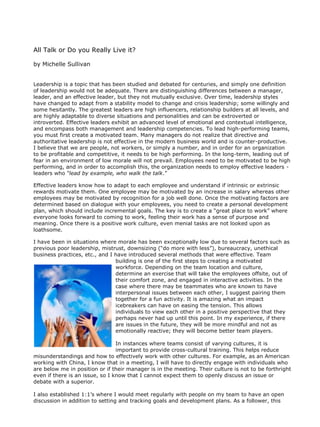
EffectiveLeader
- 1. All Talk or Do you Really Live it? by Michelle Sullivan Leadership is a topic that has been studied and debated for centuries, and simply one definition of leadership would not be adequate. There are distinguishing differences between a manager, leader, and an effective leader, but they not mutually exclusive. Over time, leadership styles have changed to adapt from a stability model to change and crisis leadership; some willingly and some hesitantly. The greatest leaders are high influencers, relationship builders at all levels, and are highly adaptable to diverse situations and personalities and can be extroverted or introverted. Effective leaders exhibit an advanced level of emotional and contextual intelligence, and encompass both management and leadership competencies. To lead high-performing teams, you must first create a motivated team. Many managers do not realize that directive and authoritative leadership is not effective in the modern business world and is counter-productive. I believe that we are people, not workers, or simply a number, and in order for an organization to be profitable and competitive, it needs to be high performing. In the long-term, leading out of fear in an environment of low morale will not prevail. Employees need to be motivated to be high performing, and in order to accomplish this, the organization needs to employ effective leaders - leaders who “lead by example, who walk the talk.” Effective leaders know how to adapt to each employee and understand if intrinsic or extrinsic rewards motivate them. One employee may be motivated by an increase in salary whereas other employees may be motivated by recognition for a job well done. Once the motivating factors are determined based on dialogue with your employees, you need to create a personal development plan, which should include incremental goals. The key is to create a “great place to work” where everyone looks forward to coming to work, feeling their work has a sense of purpose and meaning. Once there is a positive work culture, even menial tasks are not looked upon as loathsome. I have been in situations where morale has been exceptionally low due to several factors such as previous poor leadership, mistrust, downsizing (“do more with less”), bureaucracy, unethical business practices, etc., and I have introduced several methods that were effective. Team building is one of the first steps to creating a motivated workforce. Depending on the team location and culture, determine an exercise that will take the employees offsite, out of their comfort zone, and engaged in interactive activities. In the case where there may be teammates who are known to have interpersonal issues between each other, I suggest pairing them together for a fun activity. It is amazing what an impact icebreakers can have on easing the tension. This allows individuals to view each other in a positive perspective that they perhaps never had up until this point. In my experience, if there are issues in the future, they will be more mindful and not as emotionally reactive; they will become better team players. In instances where teams consist of varying cultures, it is important to provide cross-cultural training. This helps reduce misunderstandings and how to effectively work with other cultures. For example, as an American working with China, I know that in a meeting, I will have to directly engage with individuals who are below me in position or if their manager is in the meeting. Their culture is not to be forthright even if there is an issue, so I know that I cannot expect them to openly discuss an issue or debate with a superior. I also established 1:1’s where I would meet regularly with people on my team to have an open discussion in addition to setting and tracking goals and development plans. As a follower, this
- 2. was tremendously beneficial for me to have with my managers. Depending on the team and employee, I suggest meeting weekly or bi-weekly for 30 minutes to an hour at set times to ensure they do occur. I also encourage you to get creative. Think about taking a “walking meeting.” Not only is this a healthy option, it creates a more informal setting that may foster deeper and more creative discussions. To keep the team engaged, either creating or revisiting the mission and as a team through participative decision-making is optimal, and having regular team building sessions (quarterly or bi- annually depending on the situation) will ensure this is executed. This is in addition to regularly scheduled team meetings, which should be held weekly or bi-weekly. In summary, ask yourself, are you an effective leader who is capable of being adaptable, open- minded, and willing to change? Are you truly leading by example? You have more influence than you may realize.
